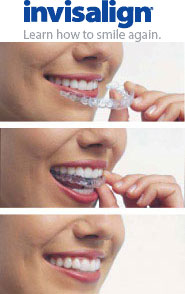
Invisalign aligners are made of soft, smooth plastic and are custom made to fit your teeth, gums and mouth during treatment. Some Invisalign patients report minor to moderate discomfort and occasional pain. The most common discomfort comment from Invisalign patients is that they feel pressure or tenderness for the first 1-2 days of changing aligners. This is a normal symptom and a great sign that the aligners are working to improve your smile.
The aligners are working to realign your teeth to the desired position that will result in your teeth being straight and healthy. Although a large amount of patients do not experience pain or discomfort, most discomfort comes from the removal and replacement of the aligners.
Invisalign patients are required to remove their aligners before eating and replace them afterwards. Your goal is to wear your aligners about 22 hours per day, unless otherwise instructed by your orthodontist. This means that you will be removing your aligners at least three to four times a day to eat your meals and snacks. In the beginning of treatment, sensitivity may be noticeable but as time goes forward the sensitivity will subside or at the very least, become familiar and tolerable.
Another occasion when Invisalign patients may feel discomfort is when they replace your aligners every two weeks with the new set. Changing your aligners is required for treatment, since each set is custom made and brings you one step closer to your perfect smile. If you were to wear the same aligner set for a long duration, your treatment will not progress and will interrupt treatment.
If you are a patient who experiences discomfort when you use your next set of aligners for the first time, there is a great tip that may help. When you are ready for your new set of aligners, put them on at night right before you go to sleep. This will allow the new aligners to start working and align your teeth into the next position of your treatment while you are able to sleep through the discomfort. This may be more comfortable for you since you don’t have to speak, chew or move your jaw when you sleep. In the morning, your teeth should be more accustomed to the new set of aligners and the discomfort will continue to decline during the next few days.
At times, the soft, plastic edges of the aligners can rub against your tongue, gums, cheeks or floor of your mouth causing slight irritation. If this occurs it is highly recommended that you contact your orthodontist for assistance. The orthodontist will either ask you to come into the office to adjust the aligner and show you how to correct it in the future or they will instruct you over the telephone how to properly adjust them for maximum comfort.
It is important to seek the assistance of your orthodontist when making adjustments to your aligners. The reason is that some adjustments to aligners may impair the treatment and cause you to need to have new aligners made. This will slow down your treatment and it can become costly with each replacement retainer.
Overall, Invisalign patients have experienced little to no discomfort or pain, while others have had mild discomfort. Your orthodontist is always there to help you and guide you in making the process as comfortable and easy as possible. If pain becomes an issue, your orthodontist will re-evaluate your treatment and possibly make changes to your customized aligners to help lessen the discomfort. Even though pressure is a common symptom from using Invisalign, it will all become worth the effort when you final results are a beautiful, healthier, happier smile.

